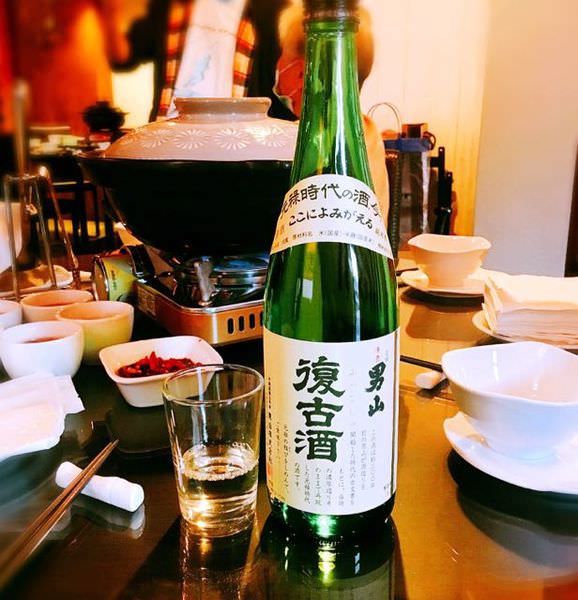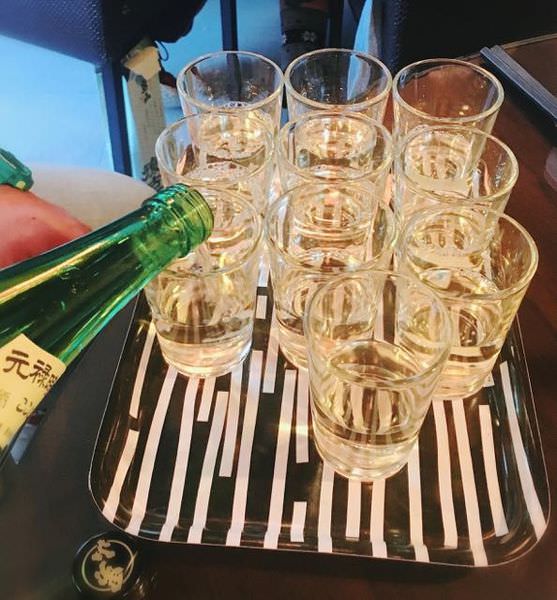【 男山純米原酒復古酒 】清酒 | Otokoyama Junmai-Shu | 北海道 | Hokkaido
Last Updated on 2024-01-04 by Foodelicious
美國人跟少許台灣人其實對日本清酒並沒有太多了解, 也許是因為網路上或書上並沒有太多中英文品牌和產品介紹, 導致很多人不敢嘗試購買清酒以免踩到地雷. “男山”是在全國(全日本)都有販售的品牌, 大約300年前就開始釀造各種清酒, 甚至早在1985年就已出口至美國 ,男山品牌在台灣也有販售, 但是此款”男山純米原酒復古酒”卻沒有進口, 所以這瓶是Mr. J 在日本購買的.身為幼幼班的我大致上整理出來一些選擇清酒需要知道的基本知識:
Most Americans and Taiwanese are not familiar with Japanese Sake. There isnt’ much English nor Chinese informations regarding brands and items on the internet nor books. However, for now, you would only need the basic informations as the following in order to select sake as a beginner. “Otokoyama” literally means “Man’s Mountain”. It is a well-known and international brand in Japan with mass production. The brewery has established for at least 300ish years and developed various sakes. But, sadly, this item (Junmai-Shu) is not selling in Taiwan. Mr. J bought it from Japan

1. 清酒的定義就是必須要是米所釀造, 其次都是一定要經過“過濾”這道工序.Sake Definition: The ingredient has to be made from rice and it must undergo a processed known as filtering.
2. 日本酒度就像紅酒的單寧是個專有名詞, 越是數字越低代表越甜 (可以是負數), 越高代表越辛口,一般的清酒都是於-2 ~ +5之間 Dryness Scale: This scale is a expression of the sweetness and dryness. The drier the sake, the higher the plus number. The sweeter the sake, the higher the minus number. However, sometimes, temperature might alter the taste.
3. 精米度60%就代表酒米的外層被磨掉40%, 很多人會說精米度越低越好但也比較貴. Rice Polishing Ratio: You can consider this as the sake category. Most people would say the lower the better but of course more expensive.
a.Higher than 60% 精米度高於60%: Junmai-shu 純米酒
b.50%~ 60% 精米度介於50% ~ 60%: Junmai ginjo-shu, Tokubetsu junmai-shu 名稱為純米吟釀酒或是特別純米酒
c.Lower than 50% 精米度低於50%: Junmai-daiginjo-shu 純米大吟釀
– –
Product Name 產品名稱: Otokoyama Junmai-Shu 男山純米原酒復古酒
Dryness Scale 日本酒度: -50
Classification 製造種類: Junmai-Shu 純米酒
Country of Origin 原產地: Hokkaido Japan 日本北海道
Rice Polishing Ratio 精米度: 65%
ABV 酒精濃度: 16 % ~ 16.9%
Total ml 總容量: 720 ml
Foodelicious 美味程度 : 🍶🍶🍶🍶
– – – – – –
很多人都不太清楚清酒應該要有哪些特色, 所以我就以會議紀錄的方式一一列出此款清酒的特色.Since many of you might not be familiar with Sake, it would be better to list out the selling points :
This sake is “GEN SHU” 此款為原酒
原酒的定義就是釀造後不加水降低酒精度, 普遍原酒的酒精濃度為20%, 此款酒精雖然濃度較低, 但是還是可以清楚地辨識道濃郁的酒香.
It means that the brewery didn’t add any water to lower its alcohol degrees. 16% is still a bit lower than other Gen Shu. But its thick aroma is still distinctive.
This sake is Junmai-Shu 此款為純米酒
純米酒的定義就是只使用酒米(日本酒的用米有專用的酒米,並非拿食用米去做酒)和只用米所作的天然酵母 (有的釀酒酵母是人工酵母), 這是建立在300年前的古法來製作的酒. 名稱上自稱”復古酒“的原因是用優化300年前的古法來製作的酒, 由於並沒有日本規定陳放滿三年的古酒來得辛口, 此款是截然不同的口味.
Junmai-Shu’s definition is to use only “rice for sake brewery” and natural yeast instead of artificial yeast. Otokoyama stated that they use adjusted vintage brewing skill to produce this specific sake in order to develop smoothness and sweet taste. The original vintage brewing skill are mostly use on “vintage sake”, which must be fermented for at least 3 years and are mostly dry.
This sake is not over-sweet 此款清酒甜而不膩
雖然日本酒度-50, 但不會過甜, 喝的第一口後,厚實的甜味衝擊著味蕾, 如果不確定-50嚐起來的甜度, 梅酒的甜度大致上為-60~ -100, 但是不同於梅酒,此款清酒在沒使用醃漬梅子與糖的情況下仍能達到和梅酒相似的甜度 , 使用的酒米一定是更香甜.
No worries, it is not over-sweet even though the dryness skill is -50. Your tastebuds of course can taste the impact of sweetness. But with the balanced of alcohol and mild rice aroma, the flavor is not over sweet. If you are not sure about what -50 taste like, just remember that umeshu’s dryness scale is -60 ~ -100. But Umeshu’s sweetness comes from the which is mixed with green plum and sugar, this sake’s sweetness is from rice fermentation itself.
簡單且甜度適中是這支酒的特色, 適合的場合就是家庭聚會, 因為大部分台灣人很喜歡帶有點甜度的酒 (例如甜白酒).
Simple and mild sweet would be the two words that I would describe this sake. It is not boring at all since most Taiwanese likes sweet alcohol (such as moscato). The best occasion to drink this sake would be at family reunion since you are not sure if they can accept dry sake. It is safe to choose this sake.
警語: 飲酒過量,有害 (礙) 健康 <- 菸酒管理法規定要寫的!








